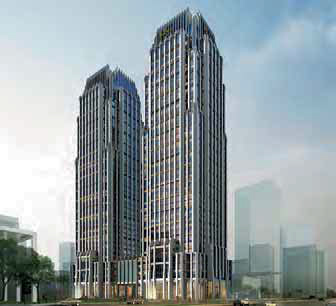Fraunhofer Building Innovation Alliance premieres at the BAU Congress China in Beijing

The twin office buildings of the planned Sino-German Industrial Service Platform in Foshan will be built with Fraunhofer IBP’s technical and scientific assistance.© Development & Management Committee
The management consultancy McKinsey & Company estimates that some 350 million people will have left the provinces for the cities by 2025. Today’s cities must prepare themselves for this influx if they are to succeed as the metropolises of tomorrow. With the BAU Congress China, the Chinese construction industry finally has its own platform for responding to the increasing demand for sustainable and environmentally friendly construction solutions.
The Fraunhofer Building Innovation Alliance, which brings together 17 Fraunhofer Institutes, has cooperated closely with the BAU trade fair in Munich for many years. On July 8 – 9, the Fraunhofer Building Innovation Alliance will present innovative developments for the cities of tomorrow at booth C05 at the National Convention Center in Beijing, along with the German Sustainable Building Council (DGNB) and industry partners. The focus will be on future-oriented city development, quality in construction and sustainable building.
Most of the fastest growing and most innovative future markets are located in Asia. Tremendous economic growth in China is driving extreme construction activity nationwide. With no end to the trend in sight, more and more Chinese are moving away from the countryside and into cities, which means that building is not limited to just individual homes – whole neighborhoods and settlements are being built. Such rapid growth leads not only to problems with quality and poor workmanship, but also building faults, unhealthy indoor climates and unnecessarily high energy consumption. The building boom in China brings with it a high demand for new building materials, building components and building systems as well as a need for new planning processes and production techniques. The demand for quality is also rising progressively.
As a central point of contact for integrated system solutions in the planning and construction sector, the Fraunhofer Building Innovation Alliance brings together the expertise and resources of 17 research institutes in the area of construction. Numerous international projects – including some in China – and the appreciation of its position as interface between industry, research and politics makes the Fraunhofer Building Innovation Alliance an attractive partner for both the Chinese construction industry and for political decision-makers in questions of urban development and planning.
Associated research in Foshan New City
As the coordinating institute for the Fraunhofer Building Innovation Alliance, the Fraunhofer Institute for Building Physics IBP is involved in projects such as the development of Foshan New City in the southern Chinese province of Guangdong. Currently, two office towers are rising into the sky as a flagship project for sustainable building. Until 2016, a team of researchers from the hygrothermics and indoor climate departments will be accompanying the project at all stages of its development – starting with the architectural competition and including the planning process, commissioning and determination of the building’s future energy consumption. The researchers will first validate and verify the results from the individual planning phases; later, they will evaluate the entire planning process with a view to results-oriented and integrated planning. The building is to be designed to meet the requirements for certification under the Chinese evaluation standards for green buildings. This evaluation system is comparable to the seal of approval from the German Sustainable Building Council (DGNB). This has motivated the researchers to compare both systems in practice and to implement some criteria from the DGNB system.
Innovative solutions for more comfort and energy efficiency
In addition to energy efficiency and sustainability, an essential aspect of urban development is comfort. This includes a pleasant and healthy indoor climate. Off-the-shelf air conditioning units often consume high amounts of energy and produce drafts or accompanying noises. An alternative would be a cooling fountain, which Fraunhofer IBP and the company Imtech will showcase at the BAU Congress China. This new type of surface cooling system pleasantly cools using natural radiant cooling and simultaneously dehumidifies the air. The water also binds dust and pollen from the air. The result is energy-efficient indoor air conditioning, and the water removed from the air – several hundred liters per month – could be used for instance for watering plants.
Visitors can learn more about the German sustainability certification, prefabricated modular façade systems and urban development systems at the Fraunhofer Building Innovation Alliance and DGNB shared exhibition stand.
As Fraunhofer IBP’s representative, Dr. Hartwig Künzel, head of the hygrothermics department, will give a lecture called “City of tomorrow – balancing comfort requirements and energy supply” at 11:15 on Tuesday, July 8. Dr. Künzel will also participate in the subsequent panel discussion “Future planning: environmental building solutions.”
Media Contact
More Information:
http://www.fraunhofer.deAll latest news from the category: Trade Fair News
Newest articles

Parallel Paths: Understanding Malaria Resistance in Chimpanzees and Humans
The closest relatives of humans adapt genetically to habitats and infections Survival of the Fittest: Genetic Adaptations Uncovered in Chimpanzees Görlitz, 10.01.2025. Chimpanzees have genetic adaptations that help them survive…

You are What You Eat—Stanford Study Links Fiber to Anti-Cancer Gene Modulation
The Fiber Gap: A Growing Concern in American Diets Fiber is well known to be an important part of a healthy diet, yet less than 10% of Americans eat the minimum recommended…

Trust Your Gut—RNA-Protein Discovery for Better Immunity
HIRI researchers uncover control mechanisms of polysaccharide utilization in Bacteroides thetaiotaomicron. Researchers at the Helmholtz Institute for RNA-based Infection Research (HIRI) and the Julius-Maximilians-Universität (JMU) in Würzburg have identified a…



